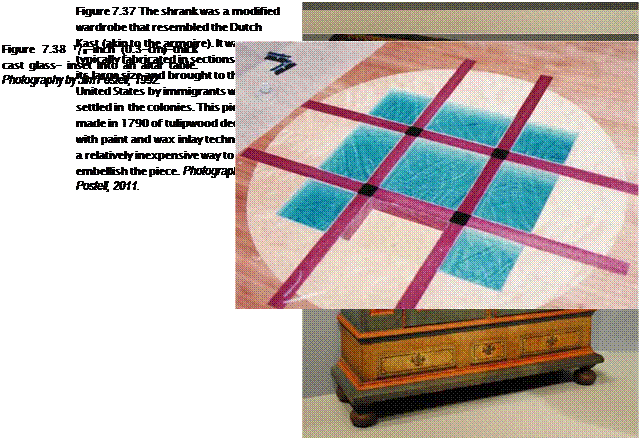Discovered by the Egyptians and perfected by the Romans, glass is one of the oldest man-made materials. Its basic material component is sand (silicon dioxide). Modern glass is approximately 75 percent silica, with lime, sodium, lead, boron, or iron added to achieve different properties. Adding metals, minerals, and oxides to silica generates a range of colors in glass. Chromium creates a green color. Manganese can remove the green-blue tint lent by iron. Cobalt yields blue. Tin and arsenic oxides make glass white. Copper oxide produces a turquoise color. Gold produces a ruby red color. Nickel produces a purple color. Uranium produces a green or fluorescent yellow color.
Glass has been used extensively in millwork and decorative insets, but on occasion it is used in furniture. Consider its use in cabinets, shelves, and tables.
Glass is an inorganic material defined as a solidified liquid because it transforms from a liquid to a solid state without crystallizing as it goes through several controlled cooling processes. The lack of a crystallizing transformation to the material results in light penetrating glass without diffusion, causing it to appear transparent.
Glass is available in many different qualities and types. Annealed glass is formed by pouring molten glass onto an iron plate covered with sand, which is where it is then smoothed with a roller before the annealing process. After annealing, the glass is ground and polished, but its faces are rarely parallel.
Float glass is produced by pouring molten glass on a molten tin surface. When the glass cools, it forms a surface that is smooth and uniform. It combines the distortion – free qualities of ground and polished plate glass with less expensive production methods.
Glass can be blown, cast, rolled, pressed, slumped, and tempered. Glass is joined by glaze (melt) bonding, clamping, or by using silicones, adhesives, and epoxies (Figure 7.38).

Stained glass is used in case goods and casework for its color, texture, and ambient quality. Stained glass is blown glass that is colored and textured using a range of techniques. Generally, stained glass has a textured side referred to as cathedral glass. Came is used to secure 1/8-inch (3-mm)-thick colored glass in place. Came is made in lead, zinc, or brass extrusions and is available in C – and H-shaped profiles.
Enamel is finely powdered silica (technically considered a glass), colored with metallic oxide and suspended in an oil medium for ease of application with a brush. It was used as an inlay material in French Rococo furniture.
Tempered glass is float glass that is heated above 600 degrees Celsius and then rapidly cooled with forced drafts of air. This process cools the glass surface below its annealing point, causing it to harden and contract, while the inner portion of the glass remains free to flow for a short time. The final contraction of the inner layer induces compressive stresses in the surface of the glass balanced by tensile stresses in the body of the glass. Observing the glass with polarized light can reveal the pattern of cooling. The tempering process places tension in the glass, making it six times as strong as annealed glass. Tempered glass is sometimes incorrectly referred to as safety glass, which is glass laminated with plastic, as in automobile windshields.
The tensile strength of tempered glass comes with a penalty. Due to the balanced stresses in the glass, any damage or force applied to the glass edges will cause the glass to shatter into hundreds of tiny pieces. Thus, tempered glass must be cut to size and drilled before tempering, and it cannot be reworked once tempered. Ironically, while tempered glass can carry heavier loads, its surface is not as hard as that of annealed glass, and it is more susceptible to scratching.
A recently developed technique to strengthen glass uses a heat-bonded transparent plastic film between two identical plates of glass. This chemical tempering process produces glass that is three times stronger than that produced by traditional tempering.
Glass can be cut using the Paser system, which involves a high-pressure pump that drives a mixture of water and abrasive powder through a cutting nozzle. The process is controlled by a computer. Preshaped and prebeveled glass is bent by placing it over heat-resistant steel and heating it in electric kilns to 630 degrees Celsius. The Ghost chair designed by Cini Boeri (see Chapter 4), produced by the Fiam company in Brianza, Italy, is an all-glass chair that results is created by using both these techniques. Glass can be welded using an adhesive that will cure only when exposed to full-spectrum UV light. The Elica table designed by Isoa Hosoe, produced by Tonelli (1988), and the Atlas table designed by Danny Lane, produced by Fiam (1988), are the result of the ability to weld glass in this manner.
Starphire glass is a glass with low iron content that is completely clear and without the pale green edge typical of most glass. Low-iron glass will also render a truer color when back-painted. Laminated or safety glass is annealed glass fused with plastic sheets that hold the glass in place when broken. Cast glass is difficult to control dimensionally but has a beautiful surface quality similar to that of ice.
Pyrex first became available in 1915. Corning research physicist Jesse Littleton cut the bottom from a glass battery jar produced by Corning, took it home, and asked his wife to bake a cake in it. The glass withstood the heat during the baking process and led to the development of borosilicate glasses for kitchenware and later to a wide range of glass products marketed as Pyrex.
In 1936, the Rohm and Haas Company of Philadelphia pressed polymethyl acrylate between two pieces of glass, thereby making a clear plastic sheet. It was the forerunner of what in the United States was called Plexiglas® (polyvinyl methacrylate). Far tougher than glass, Plexiglas is used as a substitute for glass in automobiles, airplanes, furniture, signs, and homes.



